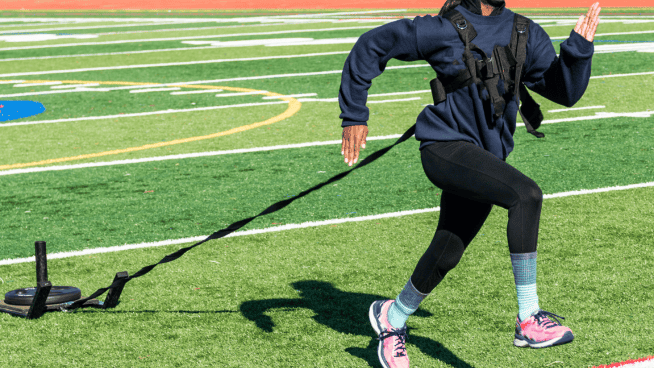Medicine Ball Training for Hockey Players
![]()
There are a few essential tools when training for hockey, and the medicine ball is one of them. If I asked you for a hockey training exercise using the medicine ball, about 70 percent of you would describe a Med Ball Rotary Pass, and the rest of you would describe a Russian Twist.
Let’s forget about the Russian Twist and talk about more productive ways you can use the med ball to build your stability and power off the ice. Check out the video player above to see NHL All-Star forward Henrik Zetterberg’s Med Ball Rotational Power Series.
Hockey Power
Med Ball Rotary Pass
This is a great exercise for developing rotational power, building from the legs and hips, transferring through the torso and ultimately finishing with the upper body. Sounds like a slap shot in hockey, doesn’t it?
The key with this one is to keep your torso strong and build momentum from the legs and hips. If you try to generate the power from your torso, you will not develop that blistering slapper that makes goalies close their eyes and wince.
Sets/Reps: 3×6, with a 6- to 8-pound medicine ball.
Watch Henrik Zetterberg’s Med Ball Rotational Power Series.
Med Ball Squat, Pass And Chase
Let’s use the med ball for a hockey-specific combination. Imagine pushing off a defender and then racing him to the puck. You need to exert your force, but then explode with your legs to reach peak speed.
With a stable torso, you will use your legs to generate power as you perform a Squat and a Push Pass with the medicine ball, sending it as far as you possibly can. As soon as the ball leaves your hands and your feet regain contact with the ground, you will transition to acceleration mode without a lag or hesitation, which would put you a half step behind on the ice.
Your goal is to get to the ball before the second bounce.
Sets/Reps: 3×6, with an 8-to 12-pound ball. Walk back for recovery if you want to work on your speed.
Hockey Stability
The med ball is such a good power implement because you can actually throw it, so you can generate maximum speed without deceleration, which helps you develop peak power.
However, that deceleration impulse has its place in your hockey training as well. You need deceleration for on-ice agility and even for taking and returning a hit.
The next two exercises are probably less familiar to you, so I want you to try them out the next time you are in the gym to assess your dynamic stability.
In-Line Kneeling Chop
The set-up for this one is key. Make sure your front foot is directly in line with your back knee. If you are kneeling with a wide base, you will miss out on the stability benefit of the exercise.
Remember to stay tall in your torso and chop quickly down on the diagonal, coming to an abrupt stop at the end. Pause for 2-3 seconds, regain your balance, then chop back up to your starting position. Again, accelerate and decelerate with each chop.
If you have mastered this drill, you will not be wiggling around or struggling to maintain your tall torso. That is when you know it’s time to increase the weight of the med ball.
Sets/Reps: 3×6, with a 4- to 6-pound med ball.
Now that you have mastered that, let’s add a layer of complexity by using the med ball as a driver to lead the movement.
Med Ball Lateral Hop And Stick
Lead the movement with the ball, almost like you’re going to do a rotary pass, except you will not let go of the ball. Instead you will bound from one leg to the other and decelerate the landing.
Stick the landing for 2-3 seconds, then load up with the med ball again and bound back to the other leg. It will be tough to stick the landing at first, but that is your goal. Do not increase the load until you can stick the landing with perfect dynamic balance.
Sets/Reps: 4×6 each leg, with a 6- to 8-pound ball.
RECOMMENDED FOR YOU
MOST POPULAR
Medicine Ball Training for Hockey Players
![]()
There are a few essential tools when training for hockey, and the medicine ball is one of them. If I asked you for a hockey training exercise using the medicine ball, about 70 percent of you would describe a Med Ball Rotary Pass, and the rest of you would describe a Russian Twist.
Let’s forget about the Russian Twist and talk about more productive ways you can use the med ball to build your stability and power off the ice. Check out the video player above to see NHL All-Star forward Henrik Zetterberg’s Med Ball Rotational Power Series.
Hockey Power
Med Ball Rotary Pass
This is a great exercise for developing rotational power, building from the legs and hips, transferring through the torso and ultimately finishing with the upper body. Sounds like a slap shot in hockey, doesn’t it?
The key with this one is to keep your torso strong and build momentum from the legs and hips. If you try to generate the power from your torso, you will not develop that blistering slapper that makes goalies close their eyes and wince.
Sets/Reps: 3×6, with a 6- to 8-pound medicine ball.
Watch Henrik Zetterberg’s Med Ball Rotational Power Series.
Med Ball Squat, Pass And Chase
Let’s use the med ball for a hockey-specific combination. Imagine pushing off a defender and then racing him to the puck. You need to exert your force, but then explode with your legs to reach peak speed.
With a stable torso, you will use your legs to generate power as you perform a Squat and a Push Pass with the medicine ball, sending it as far as you possibly can. As soon as the ball leaves your hands and your feet regain contact with the ground, you will transition to acceleration mode without a lag or hesitation, which would put you a half step behind on the ice.
Your goal is to get to the ball before the second bounce.
Sets/Reps: 3×6, with an 8-to 12-pound ball. Walk back for recovery if you want to work on your speed.
Hockey Stability
The med ball is such a good power implement because you can actually throw it, so you can generate maximum speed without deceleration, which helps you develop peak power.
However, that deceleration impulse has its place in your hockey training as well. You need deceleration for on-ice agility and even for taking and returning a hit.
The next two exercises are probably less familiar to you, so I want you to try them out the next time you are in the gym to assess your dynamic stability.
In-Line Kneeling Chop
The set-up for this one is key. Make sure your front foot is directly in line with your back knee. If you are kneeling with a wide base, you will miss out on the stability benefit of the exercise.
Remember to stay tall in your torso and chop quickly down on the diagonal, coming to an abrupt stop at the end. Pause for 2-3 seconds, regain your balance, then chop back up to your starting position. Again, accelerate and decelerate with each chop.
If you have mastered this drill, you will not be wiggling around or struggling to maintain your tall torso. That is when you know it’s time to increase the weight of the med ball.
Sets/Reps: 3×6, with a 4- to 6-pound med ball.
Now that you have mastered that, let’s add a layer of complexity by using the med ball as a driver to lead the movement.
Med Ball Lateral Hop And Stick
Lead the movement with the ball, almost like you’re going to do a rotary pass, except you will not let go of the ball. Instead you will bound from one leg to the other and decelerate the landing.
Stick the landing for 2-3 seconds, then load up with the med ball again and bound back to the other leg. It will be tough to stick the landing at first, but that is your goal. Do not increase the load until you can stick the landing with perfect dynamic balance.
Sets/Reps: 4×6 each leg, with a 6- to 8-pound ball.










